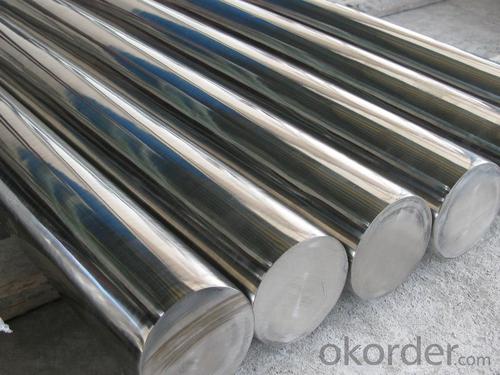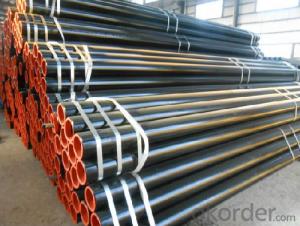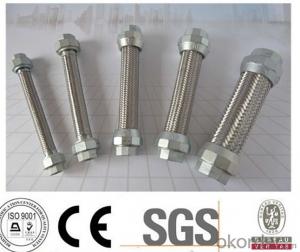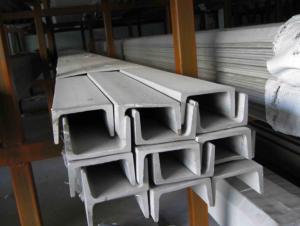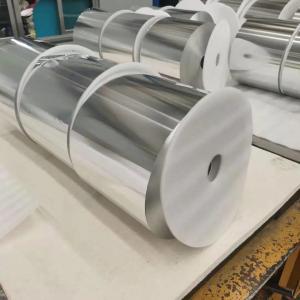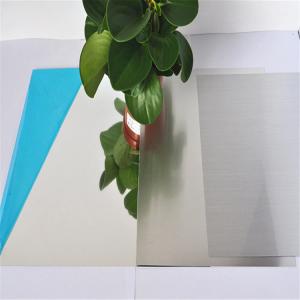Round Stainless Steel Pipes 304/316L Polished Welded Seamless
- Loading Port:
- Tianjin
- Payment Terms:
- TT OR LC
- Min Order Qty:
- 100 kg
- Supply Capability:
- 1000 kg/month
OKorder Service Pledge
Quality Product, Order Online Tracking, Timely Delivery
OKorder Financial Service
Credit Rating, Credit Services, Credit Purchasing
You Might Also Like
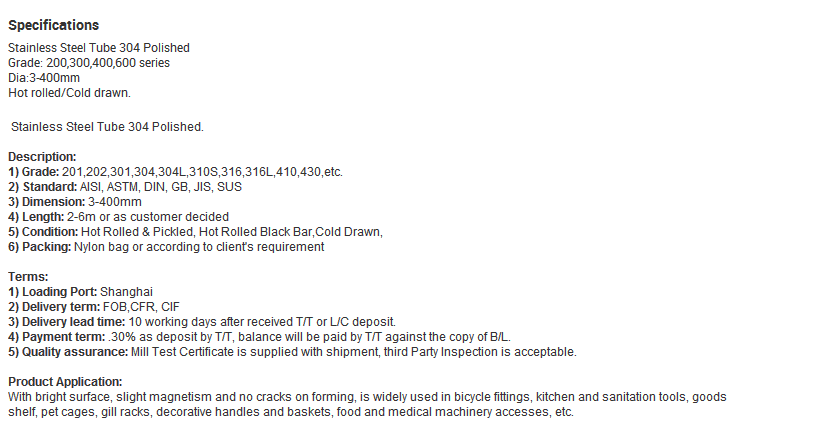

- Q:Can stainless steel pipes be used for nuclear power plants?
- Stainless steel pipes are indeed suitable for nuclear power plants. The utilization of stainless steel is widespread in the fabrication of nuclear power plants owing to its exceptional resistance against corrosion and its strength in high-temperature conditions. These characteristics are crucial for enduring the challenging operational circumstances typically encountered within nuclear power plants, including elevated temperatures and corrosive surroundings. Moreover, stainless steel is renowned for its durability and prolonged lifespan, rendering it a dependable option for pivotal purposes in the nuclear sector.
- Q:What is the difference between 321 and 316 stainless steel pipes?
- The chemical composition and intended applications distinguish 321 stainless steel pipes from 316 stainless steel pipes. 321 stainless steel pipes, containing titanium, ensure stability against chromium carbide formation, resulting in high resistance to intergranular corrosion even at elevated temperatures. Consequently, they find common use in industries like aerospace and power generation, where high temperatures are prevalent. Conversely, 316 stainless steel pipes lack titanium but incorporate molybdenum, which enhances their corrosion resistance, especially in environments with chloride ions, making them suitable for marine and coastal applications. Moreover, 316 stainless steel pipes excel in the food and beverage industry due to their exceptional resistance to acids and chemicals. To summarize, although both 321 and 316 stainless steel pipes exhibit excellent corrosion resistance, the presence of titanium in 321 stainless steel pipes elevates their resistance to intergranular corrosion at high temperatures, while the inclusion of molybdenum in 316 stainless steel pipes enhances their ability to withstand chloride-based corrosion in marine and coastal settings.
- Q:Can stainless steel pipes be used for underground sprinkler systems?
- Underground sprinkler systems can indeed utilize stainless steel pipes. Stainless steel is renowned for its durability, corrosion resistance, and capacity to withstand extreme pressure and temperature. These characteristics render it an exceptional option for subterranean applications, where pipes are exposed to moisture, soil, and various environmental elements. Moreover, stainless steel pipes are non-reactive, guaranteeing that they won't pollute the water supply or compromise the quality of the irrigation water. Nevertheless, it is crucial to ensure the proper installation of stainless steel pipes, including suitable fittings and connections, to guarantee a dependable and effective sprinkler system.
- Q:Can stainless steel pipes be bent or shaped?
- Stainless steel pipes possess the capability to undergo bending or shaping. Their favorable ductility allows for easy transformation into various shapes and configurations. Specialized equipment, including pipe bending machines or hydraulic presses, are commonly utilized to achieve this. By applying pressure at specific points, these tools induce the desired bend or formation in the pipe. The extent of bending or shaping depends on factors such as the pipe's diameter, thickness, and the desired angle or curvature. It is crucial to exercise caution during the bending process to prevent any harm or distortion to the stainless steel pipe.
- Q:What are the different types of stainless steel pipe connections?
- There are several types of stainless steel pipe connections, including threaded connections, socket weld connections, butt weld connections, and flanged connections. These connections are used to join different sections of stainless steel pipes together and ensure a secure and leak-proof connection.
- Q:What are the different end connections available for stainless steel pipes?
- The different end connections available for stainless steel pipes include threaded connections, socket weld connections, butt weld connections, flanged connections, and compression fittings.
- Q:Are stainless steel pipes suitable for oil and gas applications?
- Yes, stainless steel pipes are suitable for oil and gas applications. They have excellent corrosion resistance, high strength, and can withstand high temperatures and pressures commonly found in oil and gas operations. Additionally, stainless steel pipes are easily maintainable and have a long lifespan, making them a reliable choice for such applications.
- Q:What are the disadvantages of using stainless steel pipes?
- Although stainless steel pipes offer a multitude of advantages, it is crucial to take into account a few drawbacks: 1. Cost: Stainless steel pipes are typically more expensive than alternative pipe materials such as PVC or carbon steel. This increased cost can impact the overall project budget. 2. Limitations in Corrosion Resistance: Despite its reputation for corrosion resistance, stainless steel is not entirely impervious to corrosion. In certain environments, like highly acidic or alkaline conditions, stainless steel pipes can still corrode over time. 3. Brittle Nature: Stainless steel pipes possess a greater tendency to become brittle compared to other materials. This makes them more prone to cracking or breaking under extreme temperatures or stress. This can be problematic in applications where the pipes are subjected to significant pressure or thermal fluctuations. 4. Difficulty in Modification: In comparison to alternative pipe materials, modifying or altering installed stainless steel pipes is more challenging. This can pose a problem if any changes or adjustments need to be made in the future, as it may require additional time and effort. 5. Heat Conductivity: Stainless steel has lower heat conductivity in comparison to materials such as copper. As a result, stainless steel pipes may not efficiently transfer heat, which can be a disadvantage in applications where heat transfer is crucial. In conclusion, while stainless steel pipes offer numerous benefits, it is crucial to consider these disadvantages when selecting the appropriate material for a specific project.
- Q:How do you prevent noise transmission in stainless steel pipes?
- There exist various effective techniques for preventing noise transmission in stainless steel pipes. 1. Insulation: An effective and commonly used method for preventing noise transmission involves insulating the stainless steel pipes. To absorb and dampen sound waves, insulation materials like mineral wool, fiberglass, or foam can be wrapped around the pipes. This helps in reducing the noise transmitted through the pipes. 2. Vibration isolation: Noise transmission can also be minimized by utilizing vibration isolation techniques. This method entails the installation of flexible connectors or rubber mounts between the pipe and its supports. These isolators absorb vibrations and prevent them from being transmitted as noise through the pipe. 3. Anti-vibration pads: Another approach to prevent noise transmission is the use of anti-vibration pads. These pads are placed beneath the pipe supports to absorb vibrations and prevent their transmission as noise. They act as a barrier between the pipe and its support, significantly reducing noise transmission. 4. Acoustic lagging: The technique of applying a noise-reducing material directly onto the surface of the stainless steel pipes is known as acoustic lagging. This material, often composed of mass-loaded vinyl or rubber, acts as a barrier to block the transmission of sound waves. It effectively reduces noise transmission and can be combined with insulation for improved results. 5. Proper pipe routing: Minimizing noise transmission can be achieved by ensuring proper pipe routing. Pipes should be installed in a manner that reduces contact or proximity to other structures or surfaces that can amplify noise. Additionally, avoiding sharp bends or angles in the pipe can help in reducing noise transmission. It is important to consider that the choice of method may vary based on the specific noise issue and environment. Seeking guidance from a professional acoustic consultant or engineer is recommended to determine the most suitable solution for a particular situation.
- Q:Can stainless steel pipes be used for power plants?
- Indeed, power plants can utilize stainless steel pipes. The selection of stainless steel for power plant purposes is frequently made as a result of its exceptional resistance to corrosion and its ability to endure elevated temperatures and pressures. Given that power plants commonly operate in aggressive surroundings, they necessitate materials that can endure these conditions without deterioration. With its outstanding resistance to corrosion from chemicals, gases, and water, stainless steel pipes are perfectly suited for power plant applications. Furthermore, these pipes necessitate minimal maintenance, thereby reducing downtime and overall expenses.
1. Manufacturer Overview |
|
|---|---|
| Location | |
| Year Established | |
| Annual Output Value | |
| Main Markets | |
| Company Certifications | |
2. Manufacturer Certificates |
|
|---|---|
| a) Certification Name | |
| Range | |
| Reference | |
| Validity Period | |
3. Manufacturer Capability |
|
|---|---|
| a)Trade Capacity | |
| Nearest Port | |
| Export Percentage | |
| No.of Employees in Trade Department | |
| Language Spoken: | |
| b)Factory Information | |
| Factory Size: | |
| No. of Production Lines | |
| Contract Manufacturing | |
| Product Price Range | |
Send your message to us
Round Stainless Steel Pipes 304/316L Polished Welded Seamless
- Loading Port:
- Tianjin
- Payment Terms:
- TT OR LC
- Min Order Qty:
- 100 kg
- Supply Capability:
- 1000 kg/month
OKorder Service Pledge
Quality Product, Order Online Tracking, Timely Delivery
OKorder Financial Service
Credit Rating, Credit Services, Credit Purchasing
Similar products
New products
Hot products
Hot Searches
Related keywords

